At a glance
Expert's Rating
Pros
- Compact IP68-rated form factor
- Attractive styling
- Top-shelf real world 20Gbps performance
- Captive port plug
Cons
- Slows drastically off secondary cache
Our Verdict
Adata’s IP68-rated SD820 SSD delivers excellent real world 20Gbps performance in a small package, and at an affordable price point. But it will slow drastically during very long writes.
Price When Reviewed
This value will show the geolocated pricing text for product undefined
Best Pricing Today
Best Prices Today: Adata SD820 SSD
Being unabashedly shape-conscious, I was prone to liking the Adata SD820 right off the bat. Its bright blue highlights are a bit garish in bright light, but I like that — makes it easy to spot in the wild. The fact that it’s a good 20Gbps performer with 2TB on board just sweetened the deal. Attractive and useful. What’s not to like?
Well, one thing. If you write too much data at once (more than 20 percent of capacity), the drive will run out of secondary cache and slow to around 130MBps. Otherwise, the SD820 turned in the fastest real world performance we’ve seen from a 20Gbps SSD.
Adata SD820: Features
The SD820 is a small, flat-ish, bright-blue-and-black rectangle measuring around 2.65-inches long by 1.5-inches wide by 0.4-inches thick. It weighs a mere 0.9 ounces.
It’s more than suitable for outdoor use according to its IP68 rating. If you aren’t feeling curious enough to click on that link, IP68 means the SD820 is dustproof and can survive immersion in 10 feet of water. That’s as good as it gets for consumer devices.
The SD820 sports a female Type-C connector protected by a captive plastic cap and Adata includes a Type-C to Type-C cable.
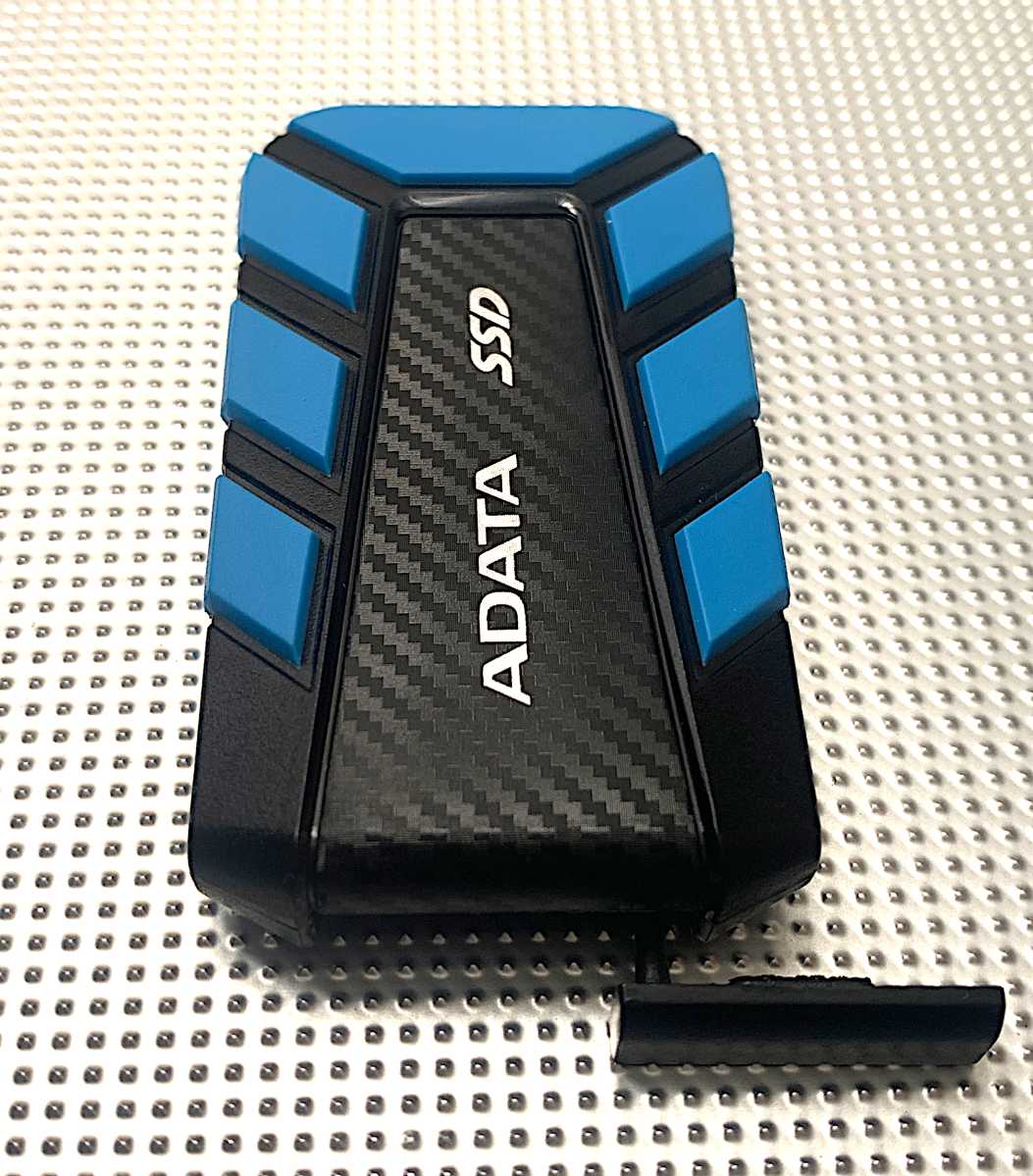
While the color scheme may seem a bit garish to some, it also means you’ll be able to more easily find the little sucker if you drop it on the trail. Neon orange, lime, or pink are a bit better for that in my experience, but the blue will do.
The SD820 is 20Gbps USB 3.2×2, the controller is a Silicon Motion SM2322, and the NAND is layered QLC. USB 3.2×2 is 20Gbps when attached to a dedicated USB 3.2×2 port and some USB4 ports, but it drops to 10Gbps or lower in most Thunderbolt ports, and all non-USB4 ports.
Adata warranties the SD820 for five years, which is two years more generous than most external SSDs. The company did not provide a TBW (TeraBytes that may be Written) rating, but QLC of this type (older) is generally around 250TBW per terabyte of capacity.
Adata SD820: Pricing
The SD820 will be available in $102/1TB and $179/2TB as of mid-November 2025, and eventually in 4TB capacity. Not sure about the price yet, but I’d guess around $400. That’s not bad at all for IP68-rated 20Gbps SSDs. You can go a bit cheaper without the IP-rating, and a lot more expensive is you want better write performance with large amounts of data. As to that…
Adata SD820: Speed
With normal amounts of data, the SD820 is among the fastest 20Gbps SSDs we’ve tested. Faster in sequential throughput than random ops, but still very fast overall.
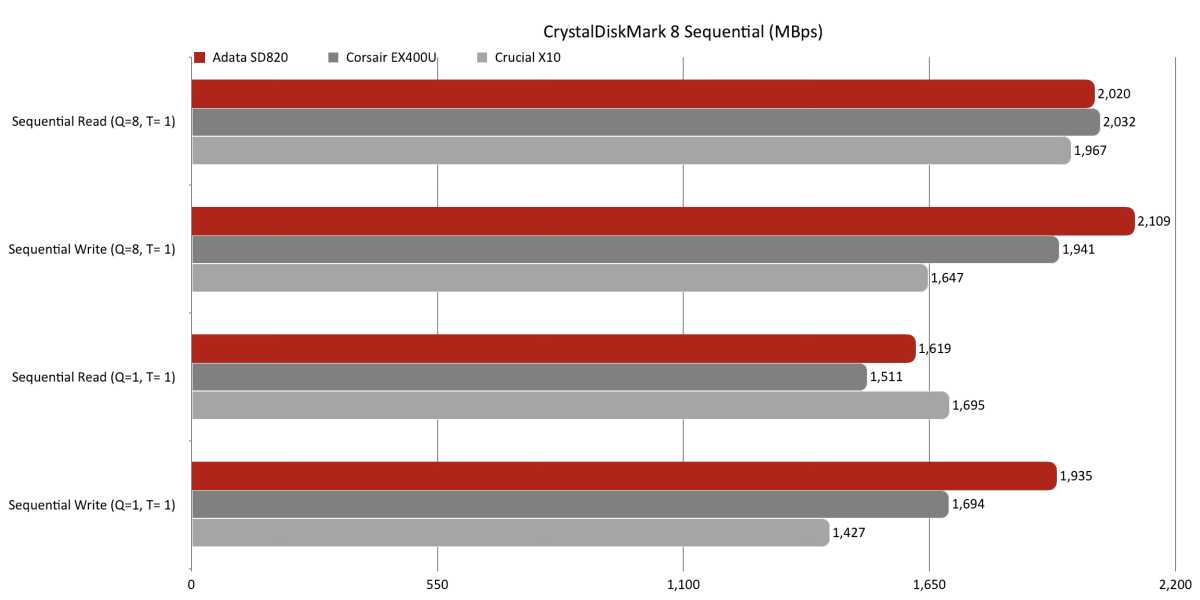
Although 4K reads are competitive, the SD820 fell well behind its rivals in 4K writing. Overall, not bad, not great.
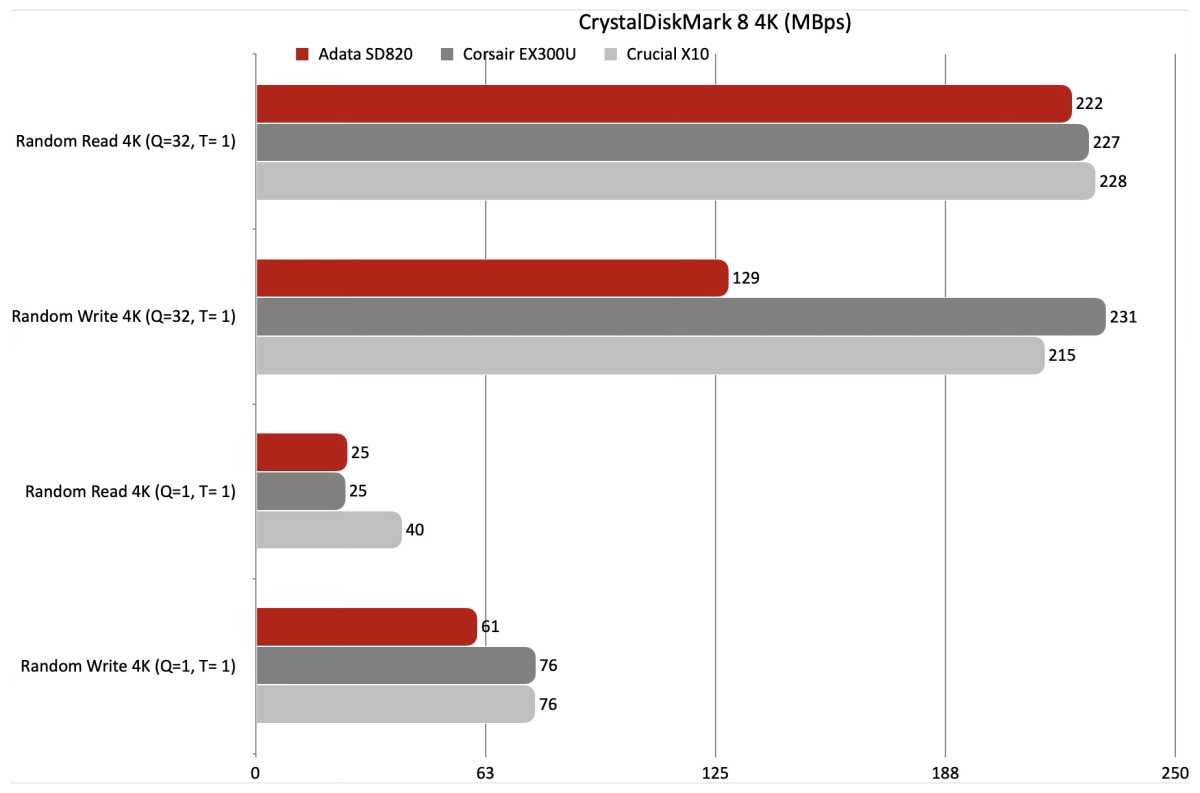
Where the SD820 really brought home the bacon was in our 48GB transfer tests. It shaved quite a few seconds off the times of the the two listed competitors, the Corsair EX400U and Crucial X10 (chosen because of their similar bulk) and is the fastest of all the 20Gbps SSDs and enclosures we’ve tested.
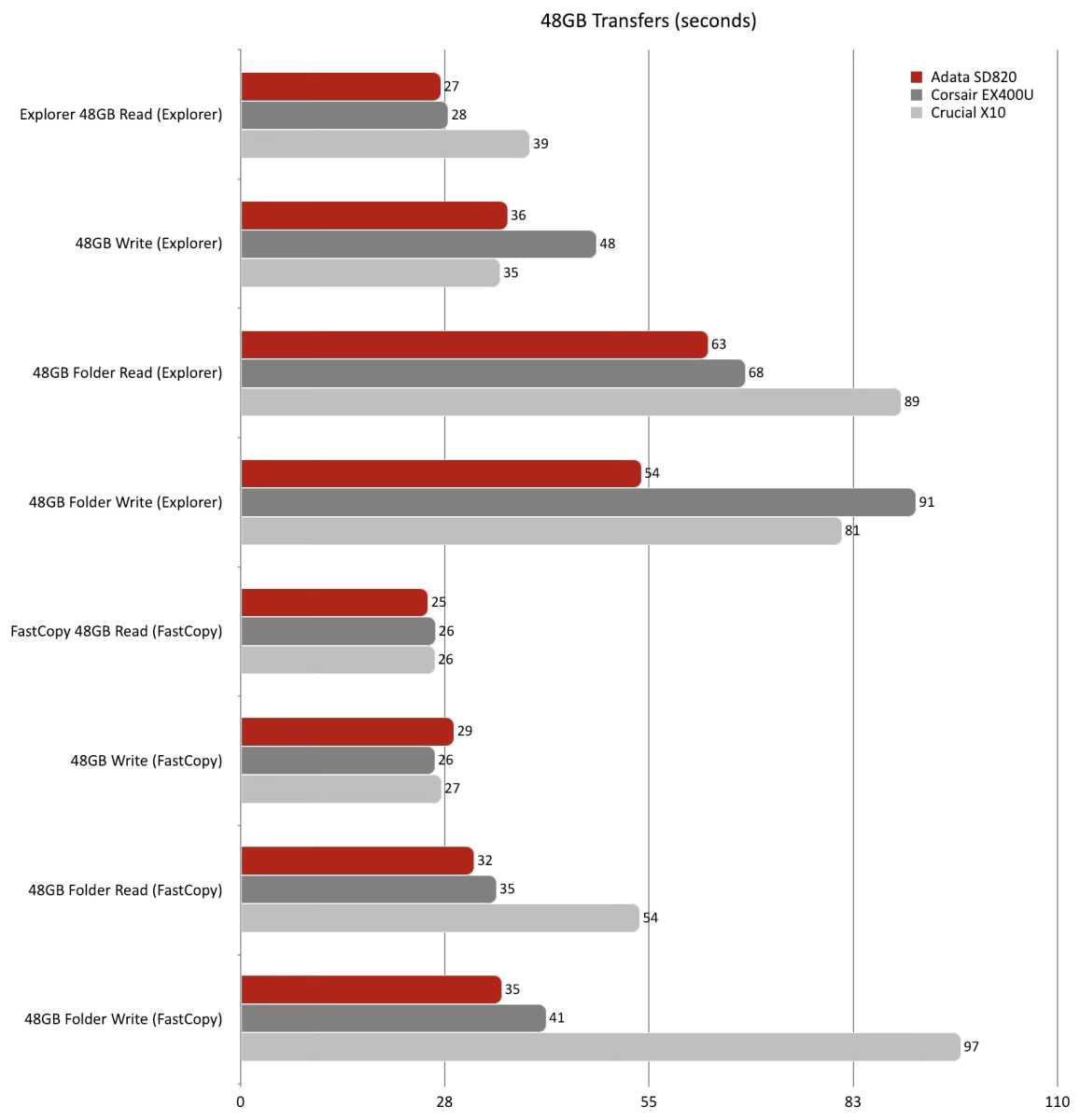
The SD820 was actually on pace for much faster time in the 450GB write, when at around the 85 percent mark it ran out of secondary cache (second image below). The QLC’s 130MBps native write speed dropped the sea anchor on a competitive time.
For real world transfers of normal size, the SD820 is the portable 20Gbps SSD to beat.
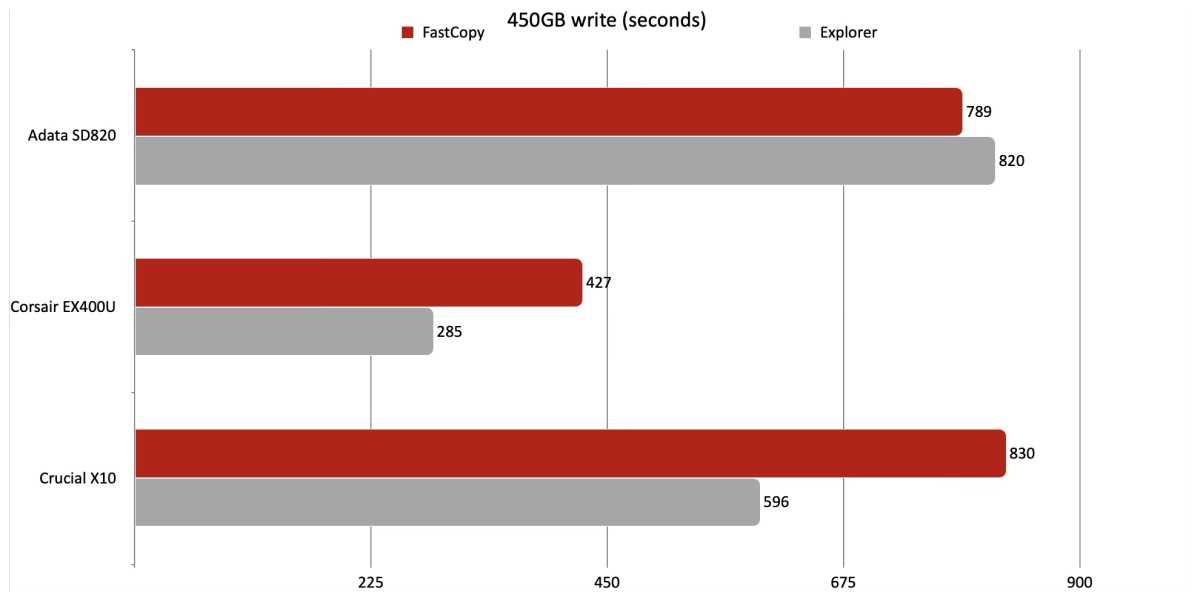
Here’s a screen capture of the native write slowdown at the 85 percent mark. The QLC must be of the older variety as we’ve seen newer QLC maintain around 400Mbps to 500MBps. But basically, if you write this much data regularly (few do — even us outside of testing), you might opt for a TLC SSD.
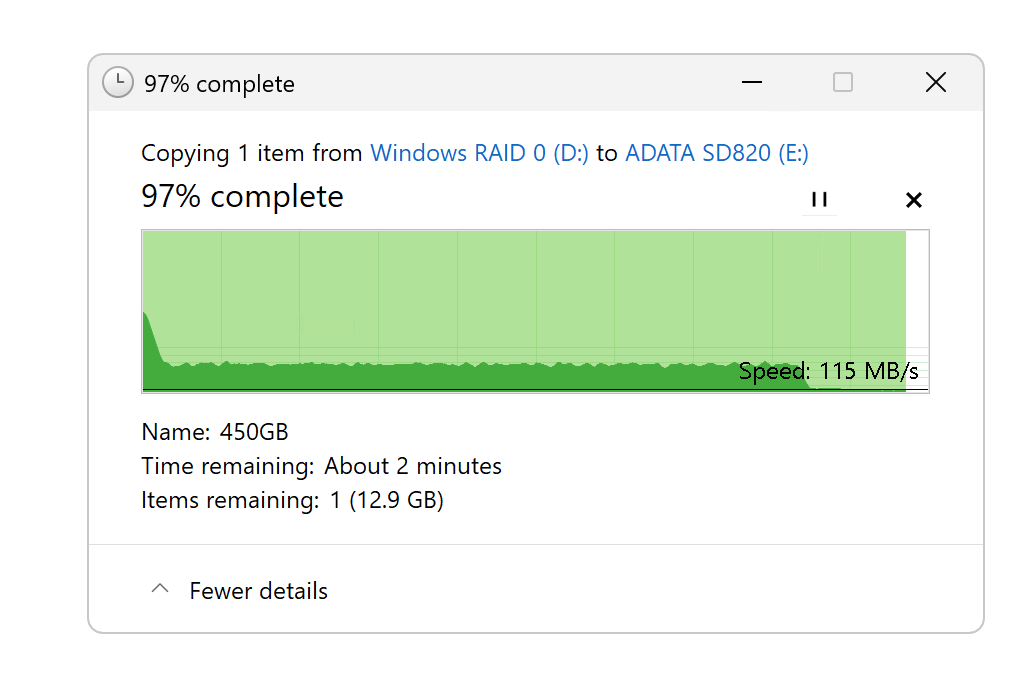
For real world transfers of normal size, the SD820 is the portable 20Gbps SSD to beat. However, users regularly writing very large amounts of data, something sporting TLC NAND and USB4 might serve them better in the long run.
Adata SD820: Conclusion
If you’re looking for rugged storage at a decent price and like the look, give the Adata SD820 a good, hard look. The SD820 isn’t quite pro-level, but it’s easily fast enough and vast enough for the average user, especially those working in the wild.
Adata SD820: How we test
Drive tests currently utilize Windows 11 24H2, 64-bit running off of a PCIe 4.0 Samsung 990 Pro in an Asus Z890-Creator WiFi (PCIe 4.0/5.0) motherboard. The CPU is a Core Ultra i5 225 feeding/fed by two Crucial 64GB DDR5 4800MHz modules (128GB of memory total).
Both 20Gbps USB and Thunderbolt 5 are integrated into the motherboard and Intel CPU/GPU graphics are used. Internal PCIe 5.0 SSDs involved in testing are mounted in a Asus Hyper M.2 x16 Gen5 adapter card siting in a PCIe 5.0 slot.
We run the CrystalDiskMark 8.04 (and 9), AS SSD 2, and ATTO 4 synthetic benchmarks (to keep article length down, we only report one) to find the storage device’s potential performance, then a series of 48GB and 450GB transfers tests using Windows Explorer drag and drop to show what users will see during routine copy operations, as well as the far faster FastCopy run as administrator to show what’s possible.
A 20GBps two-SSD RAID 0 array on the aforementioned Asus Hyper M.2 x16 Gen5 is used as the second drive in our transfer tests. Formerly the 48GB tests were done with a RAM disk serving that purpose.
Each test is performed on a NTFS-formatted and newly TRIM’d drive so the results are optimal. Note that in normal use, as a drive fills up, performance may decrease due to less NAND for secondary caching, as well as other factors. This issue has abated somewhat with the current crop of SSDs utilizing more mature controllers and far faster, late-generation NAND.
Note that our testing MO evolves and these results may not match those from previous articles. Only comparisons inside the article are 100% valid as those results are gathered using the current hardware and MO.







